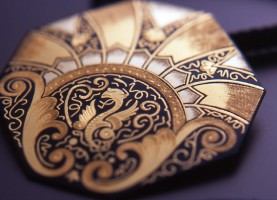

金属に金や銀、赤銅などをはめ込んで模様で装飾する象嵌は、シリアのダマスカスで生まれ、日本には飛鳥時代(6~7 世紀)に伝わったとされています。平安時代(8 末~12 世紀)には技術の基盤ができ、江戸時代(17~19 世紀)には京都の埋忠、 正 阿弥など刀やよろいなどをつくる職人が優れた象嵌を生みました。京都の象嵌は、鉄、銅、真鍮 などの地金に縦横の細かい布目の溝を彫り、金、銀、銅などを鎚で打ち込んでいく布目象嵌を中心としており、繊細な美しさが特徴です。
Originating in the area of present-day Syria, the art of inlaying gold, silver, copper, or other materials into a base metal entered Japan during the Asuka Period(6th-7th centuries). Current techniques were refined during the Heian Period(8th-12th centuries), and during the Edo Period(17th-19th centuries) Umetada, Shoami, and other craftsmen skilled in making swords and armor produced outstanding inlay work.Characterized by fine detail, nunome inlay – in which the artisan etches fine textile-like lines into the base metal(iron, copper, brass), and then beats gold, silver, or copper into the etched pattern with a mallet – is the most common form of inlay produced in Kyoto.
古代、中東から伝わったわざ、象嵌
漆黒と金銀が描く美しいコントラスト
Zogan – a technique originating in the Middle East.
A beautiful contrast of jet black, gold and silver.



